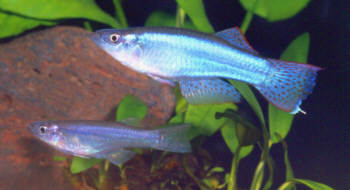Procatopus aberrans Ahl 1927

Procatopus
gracilis (now aberrans).
Photo: Courtesy of Ed Pürzl
| Meaning of Name | From
Kadlec (BKA K/N 272) Pro = front, cato = hold, pous = foot. | |
| First Description |
| |
| Size |
6 cm. Females can be 2 cm smaller. | |
| Meristics |
D = 7-8, A = 15-16, ll = 30 (from type specimens ?). | |
| Karyotype |
n = 25 | |
| Sub-Genus |
| |
| Group |
| |
| Synonyms |
| |
Populations
|
Adoro - Collected in June/July 1977 by Fred Wright, Road Roberts et al near the village of Adoro in the Anambra drainage, Northern Nigeria. This biotope was a strongly flowing turbid stream in primeval forest which only received light in areas where the road crossed it. At 13.45 hrs water temperature 79°F pH 6·3, DH 2, water depth 1 - 4 feet was recorded. Few aquatic plants were present, the stream flowing over laterite & clay with a heavy covering of rotting vegetation. This was the only sp. of killifish found. Other sp. included were Characin & Cichlid. Another stream close by had a stony base with a swift flow. This was 30 feet across in parts & 4 feet deep. |
|
| Type Locality | Four specimens were collected at Ossiding near Eyomojok. These were deposited in the Zoological Museum of the Humboldt University in Berlin. | |
| Distribution |
| |
| Habitat |
Found in rainforest streams near savannah areas. Also found in savannah areas of Nigeria & Cameroon. | |
| Distinguishing Characteristics | ||
| Colour/Pattern Variability | ||
| History |
| |
| Breeding Notes |
A breeding report appeared in BKA newsletter
No. 154, June 1978 by P.Goris who used water with a neutral pH &
no harder than DH 10. Eggs were laid in fissures near the water surface,
cork, bark, stones etc. The female was observed to eject the eggs with
such violence that they would attach themselves to bark above the water
surface. Finding eggs in wet bark was considered very difficult &
the bark was dried off for 10 minutes prior to collection. Jacqueline Cammidge wrote an article in BKA newsletter
No.375, December 1996. Breeding tank was a 12 x 8 x 8" filled to
4" of water. Water temperature 78°F, pH 7·4, GH 25.
A sponge filter was added to stimulate flow rate plus a floating mop.
The mop was inspected after 3 days & 32 eggs were found which were
pushed into small crevices. Eggs were found near the surface in the
mop & cork. A sponge was tried to see if they laid in this but they
preferred the mop. | |
| Diameter of Egg | ||
| Remarks |
Full size is attained at 14-18 months of age. Reports suggest they are long lived, reaching 4 years of age. |
